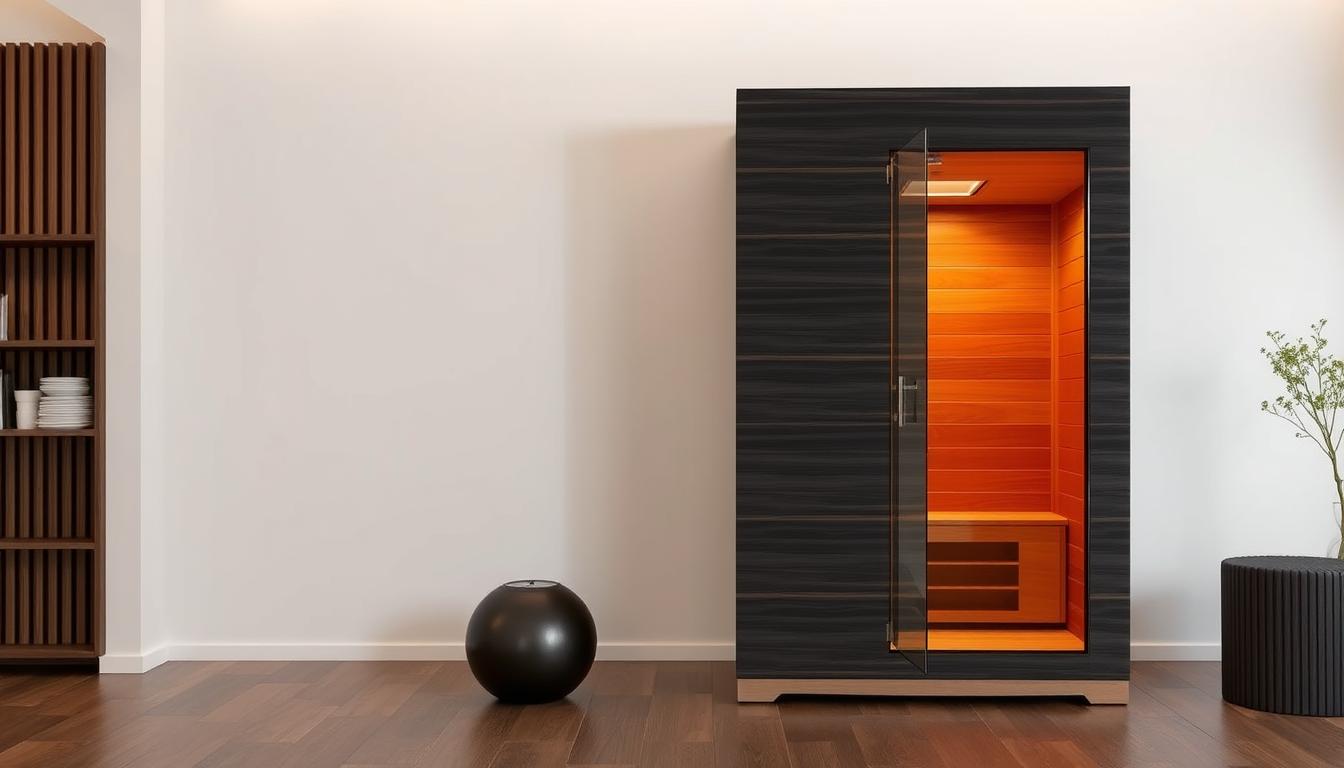
Exploring the Potential Risks of Infrared Saunas
Infrared saunas have gained popularity in recent years due to their potential health benefits, including detoxification and relaxation. Infrared heat therapy is believed to provide these benefits by penetrating deep into the body, promoting sweating and circulation.

As with any form of heat therapy, there are potential risks associated with using infrared saunas. It's essential to understand these risks to ensure safe and effective use. Some individuals may experience adverse effects, particularly if they have certain medical conditions or fail to follow proper safety precautions.
Key Takeaways
- Infrared saunas offer potential health benefits, including detoxification and relaxation.
- Understanding the potential risks is crucial for safe usage.
- Certain medical conditions may increase the risk of adverse effects.
- Following safety precautions can minimize risks.
- Awareness of infrared sauna safety guidelines is essential.
What Are Infrared Saunas and How Do They Work?
The science behind infrared saunas reveals a complex interplay of heat, light, and human physiology. Unlike traditional saunas that rely on heating the air to warm the body, infrared saunas use infrared radiation to directly heat the body. This distinction is crucial for understanding the unique benefits and potential risks associated with infrared sauna use.
The Science Behind Infrared Technology
Infrared technology is based on the principle that all objects emit infrared radiation, which is a form of electromagnetic radiation. When this radiation is directed at the human body, it penetrates deep into the tissues, causing a rise in body temperature. This process is known as deep heating, and it stimulates various physiological responses that can lead to several health benefits.
Different Types of Infrared Saunas
There are three main types of infrared saunas, categorized by the wavelength of the infrared radiation they emit: near, mid, and far infrared.
- Near-infrared saunas emit shorter wavelengths that penetrate less deeply into the body but are believed to have benefits for skin health.
- Far-infrared saunas emit longer wavelengths that penetrate more deeply and are associated with deeper tissue heating.
- Mid-infrared saunas fall between near and far infrared in terms of wavelength and penetration depth.
Each type has its unique benefits, and some saunas combine different wavelengths to offer a broader range of effects.
How Infrared Heat Affects the Body
The deep heating caused by infrared radiation can lead to several physiological effects, including increased heart rate, sweating, and improved circulation. These effects are believed to contribute to the potential health benefits of infrared saunas, such as detoxification, pain relief, and relaxation. However, it's essential to understand these effects to use infrared saunas safely and effectively.
In conclusion, infrared saunas offer a unique approach to health and wellness through the application of infrared technology. By understanding how they work and the different types available, users can make informed decisions about their use.
Potential Health Benefits of Infrared Saunas
Infrared saunas have gained popularity for their potential to offer various health benefits, ranging from detoxification to pain relief. These benefits are attributed to the infrared heat, which penetrates deeper into the body compared to traditional saunas.
Detoxification Claims
One of the most commonly cited benefits of infrared saunas is their ability to promote detoxification. The deep penetration of infrared heat is believed to cause a more vigorous sweat, potentially removing toxins from the body. However, it's essential to note that the scientific evidence supporting this claim is mixed.
Pain Relief and Muscle Recovery
Infrared saunas are also used for pain relief and muscle recovery. The infrared heat helps reduce inflammation and relax muscles, making it a popular choice among athletes. Studies have shown that regular infrared sauna use can lead to significant reductions in muscle and joint pain.
Cardiovascular Effects
Regular use of infrared saunas may have positive effects on cardiovascular health. The heat stress from infrared saunas can improve circulation, lower blood pressure, and increase cardiac output. A study comparing the cardiovascular effects of infrared saunas and traditional saunas found both to be beneficial, but the infrared sauna was better tolerated by some participants.
| Health Benefit | Description | Evidence Level |
|---|---|---|
| Detoxification | Removal of toxins through sweating | Moderate |
| Pain Relief | Reduction in muscle and joint pain | Strong |
| Cardiovascular Health | Improved circulation and lower blood pressure | Strong |
https://www.youtube.com/watch?v=iBJJD5MbsaE
Understanding the Risks of Infrared Sauna Use
While infrared saunas offer numerous health benefits, it's crucial to understand the potential risks associated with their use. As with any health treatment, infrared sauna therapy is not without its downsides.
Short-term Side Effects
Some individuals may experience short-term side effects when using infrared saunas, including dizziness, nausea, and dehydration. These effects are often due to the intense heat and can be mitigated by proper hydration and gradual acclimation to the sauna environment.
It's also important to be aware of the signs of heat exhaustion, such as heavy sweating, pale skin, fast and weak pulse, nausea or vomiting, and dizziness or fainting.
Potential Long-term Concerns
While short-term use is generally considered safe, there is limited research on the long-term effects of regular infrared sauna use. Potential long-term concerns may include impacts on blood pressure, heart rate, and the body's ability to regulate temperature.
| Potential Risk | Description | Precaution |
|---|---|---|
| Dehydration | Loss of fluids due to excessive sweating | Drink plenty of water before, during, and after sauna use |
| Heat Exhaustion | Condition caused by overheating | Monitor body temperature, exit sauna if feeling unwell |
| EMF Exposure | Potential health risk due to electromagnetic fields | Choose saunas with low EMF levels, limit exposure time |
Electromagnetic Field (EMF) Exposure Concerns
Some infrared saunas may emit high levels of electromagnetic fields (EMFs), which have raised health concerns. Choosing a sauna with low EMF levels or using shielding materials can help minimize exposure.
By understanding these risks and taking appropriate precautions, individuals can safely enjoy the benefits of infrared sauna therapy.
Dehydration and Overheating Dangers
While infrared saunas offer numerous health benefits, they also pose risks of dehydration and overheating. It's crucial for users to understand these dangers to safely enjoy the therapeutic effects of infrared saunas.
Signs of Heat Exhaustion During Sauna Sessions
Heat exhaustion is a serious condition that can occur when the body loses too much water and salt, usually due to excessive sweating. Signs of heat exhaustion during sauna sessions include:
- Dizziness or lightheadedness
- Nausea or vomiting
- Headaches
- Rapid heartbeat
- Low blood pressure
If you experience any of these symptoms, it's essential to exit the sauna immediately and rehydrate.
Proper Hydration Protocols
To avoid dehydration, it's recommended to drink water before, during, and after sauna sessions. The amount of water can vary, but a general guideline is to drink at least 8-10 glasses of water per day when using a sauna regularly.
| Hydration Timing | Recommended Water Intake |
|---|---|
| Before Sauna | 1-2 glasses |
| During Sauna | 1 glass every 20 minutes |
| After Sauna | 1-2 glasses |
When to Exit the Sauna
It's vital to know when to exit the sauna to prevent overheating and dehydration. If you experience any signs of heat exhaustion, or if you feel uncomfortable, it's time to exit. Additionally, limiting your sauna sessions to 20-30 minutes can help prevent these issues.

By being aware of the signs of heat exhaustion, following proper hydration protocols, and knowing when to exit the sauna, you can minimize the risks associated with infrared sauna use.
Cardiovascular Risks and Blood Pressure Concerns
While infrared saunas offer several health benefits, their use is not without cardiovascular risks. It's essential to understand how infrared sauna heat affects the body, particularly for individuals with pre-existing heart conditions.
How Heat Affects Blood Pressure
The heat from infrared saunas causes blood vessels to dilate, which can lead to a decrease in blood pressure. However, this effect can also result in increased heart rate as the body attempts to maintain blood flow to vital organs.
Increased heart rate can be a concern for people with certain heart conditions. It's crucial to monitor how your body responds to the heat.
Risks for People with Heart Conditions
Individuals with heart conditions should consult their healthcare provider before using an infrared sauna. The heat can exacerbate certain conditions, such as heart failure or arrhythmias.
| Heart Condition | Potential Risk | Precaution |
|---|---|---|
| Heart Failure | Increased strain on the heart | Consult healthcare provider |
| Arrhythmias | Heat-induced irregular heartbeat | Monitor heart rhythm during use |
Monitoring Your Heart Rate During Sessions
It's advisable to monitor your heart rate during infrared sauna sessions. If you experience any discomfort, dizziness, or pain, exit the sauna immediately.
By being aware of the potential cardiovascular risks and taking necessary precautions, you can enjoy the benefits of infrared sauna use while protecting your heart health.
Medication Interactions and Infrared Heat
For people taking prescription medications, understanding the potential interactions with infrared sauna use is vital for safe enjoyment. Infrared saunas, while beneficial for relaxation and health, can complicate the effects of certain medications.
Prescription Medications That May Increase Risk
Some medications can increase the risk of adverse effects when used in conjunction with infrared sauna therapy. These include:
- Medications for blood pressure, as they may cause hypotension (low blood pressure) when combined with the heat.
- Certain antidepressants, which can lead to serotonin syndrome when overheating occurs.
- Diuretics, which can exacerbate dehydration if not properly managed.
Alcohol and Sauna Use
Combining alcohol with infrared sauna use can significantly increase the risk of dehydration and heat-related illnesses. Alcohol impairs the body's ability to regulate its temperature, making it harder to cool down during sauna sessions.
Consulting Healthcare Providers Before Use
It's essential for individuals, especially those on prescription medications, to consult with their healthcare providers before starting infrared sauna therapy. This consultation can help identify potential risks and ensure safe usage.
| Medication Type | Potential Risk | Precaution |
|---|---|---|
| Blood Pressure Medications | Hypotension | Monitor blood pressure before and after sauna use. |
| Certain Antidepressants | Serotonin Syndrome | Avoid overheating; stay hydrated. |
| Diuretics | Dehydration | Hydrate before, during, and after sauna sessions. |
Pregnancy and Fertility Considerations
Infrared saunas, known for their therapeutic benefits, pose specific considerations for pregnant women and those trying to conceive. The heat generated by infrared saunas can have various effects on the body, and it's crucial to understand these impacts to ensure safe usage.
Research on Heat Exposure During Pregnancy
Studies have shown that high temperatures can affect fetal development. Heat exposure during pregnancy has been linked to potential risks, including miscarriage and birth defects. A study published in the Journal of Reproductive Medicine found that sauna use during early pregnancy might increase the risk of miscarriage. However, more research is needed to fully understand these risks.
"The critical period for heat-related damage to the fetus is during the first trimester," notes Dr. Jane Smith, an obstetrician. "Pregnant women should be cautious with activities that significantly raise their body temperature."
Male Fertility Concerns
The impact of infrared sauna use on male fertility is another area of concern. Elevated testicular temperatures can affect sperm production and quality. Research suggests that frequent sauna use may temporarily reduce sperm count and motility. However, these effects are typically reversible once the body temperature returns to normal.
Recommendations for Expectant Parents
For pregnant women or those planning to conceive, it's advisable to consult with a healthcare provider before using an infrared sauna. Here are some guidelines to follow:
- Limit sauna sessions to 15-20 minutes.
- Avoid high temperatures above 100°F (38°C).
- Stay hydrated before, during, and after sauna use.
- Be aware of your body's response and exit the sauna if you feel uncomfortable.
By being informed and cautious, expectant parents can make safe choices regarding infrared sauna use.
Skin Sensitivity and Burns
Infrared saunas, while beneficial for many, can pose specific risks to users, particularly regarding skin sensitivity and burns. It's essential to understand how infrared heat affects different skin types to mitigate these risks.
How Infrared Affects Different Skin Types
Different skin types respond variably to infrared heat. Individuals with fair skin may be more susceptible to burns due to lower melanin levels, while those with darker skin tones might have a different response due to their skin's melanin content. It's crucial to be aware of your skin type and its limitations when using an infrared sauna.
- Fair skin: More susceptible to burns; start with lower temperatures and shorter sessions.
- Darker skin tones: May have a higher tolerance but should still be cautious.
- Sensitive skin: May react more strongly to infrared heat; consider shorter sessions and monitor skin response.
Preventing Burns and Skin Damage
To enjoy the benefits of infrared saunas while minimizing risks, follow these guidelines:
- Start with lower temperatures and gradually increase as needed.
- Limit initial sessions to 15-20 minutes and adjust based on comfort.
- Stay hydrated before, during, and after sauna use.
- Avoid sauna use if you have open wounds or certain skin conditions.

Products to Avoid Before Sauna Sessions
Certain products can increase the risk of skin irritation or burns when using an infrared sauna. Avoid applying the following before a sauna session:
- Products containing retinol or glycolic acid.
- Certain essential oils that may cause skin irritation when heated.
- Makeup or lotions that could trap heat.
By being mindful of these factors, you can significantly reduce the risk of skin damage and enjoy the therapeutic benefits of infrared saunas.
Comparing Risks: Infrared vs. Traditional Saunas
Infrared and traditional saunas offer different experiences and benefits, but how do their risks compare? Understanding these differences is key to making an informed decision about which type of sauna might be best for you.
Temperature and Humidity Differences
One of the primary distinctions between infrared and traditional saunas lies in their heating methods and the resulting temperature and humidity levels. Traditional saunas heat the air to high temperatures, often between 150°F to 200°F, causing the body to sweat profusely. In contrast, infrared saunas use infrared heaters to warm the body directly, operating at lower ambient temperatures, typically between 120°F to 150°F, but still inducing a deep sweat.
Unique Risks of Each Type
Traditional saunas pose risks associated with high heat and humidity, which can lead to dehydration if not properly managed. Infrared saunas, while generally considered gentler, can still cause overheating and have raised concerns regarding electromagnetic field (EMF) exposure due to the electric heaters used.
Which Is Safer for Different Health Conditions
For individuals with certain health conditions, one type of sauna may be safer than the other. For example, those with cardiovascular issues might find infrared saunas more comfortable due to the lower temperatures. However, it's crucial to consult with a healthcare provider before starting any sauna regimen, especially for those with pre-existing health concerns.
In conclusion, both infrared and traditional saunas have their unique risks and benefits. By understanding these differences and considering individual health conditions, users can make informed choices about their sauna use.
Safe Usage Guidelines for Infrared Saunas
The safe use of infrared saunas requires knowledge of proper session duration, preparation, and recovery practices. To enjoy the benefits while minimizing risks, users must be aware of several key guidelines.
Recommended Session Duration and Frequency
It's essential to start with shorter sessions (20-30 minutes) and gradually increase the duration as your body adapts. The frequency of use can vary, but typically, 2-3 times a week is recommended for optimal benefits. Listening to your body and not exceeding your comfort level is crucial.
Proper Preparation Before Sessions
Before using an infrared sauna, ensure you're well-hydrated by drinking plenty of water. Avoid heavy meals and strenuous exercise at least an hour before your session. It's also advisable to remove any jewelry and shower before entering the sauna.
Post-Sauna Recovery Practices
After your sauna session, it's vital to cool down properly to avoid dizziness or fainting. Replenishing electrolytes is also important to replace lost salts. Monitoring for any adverse reactions such as headaches or nausea is crucial, and you should adjust your usage accordingly.
Cooling Down Properly
Take your time to cool down after a sauna session. Sit or lie down in a cool area and avoid sudden movements.
Replenishing Electrolytes
Drink electrolyte-rich beverages or consume foods high in electrolytes to restore your body's balance.
Monitoring for Adverse Reactions
Pay attention to your body's response after sauna use. If you experience any negative effects, consider reducing the frequency or duration of your sessions.
Conclusion: Balancing Benefits and Risks for Responsible Sauna Use
Infrared saunas offer numerous health benefits, from detoxification and pain relief to improved cardiovascular health. However, like any health practice, they come with potential risks that must be considered. By understanding these risks and taking steps to mitigate them, individuals can enjoy the benefits of infrared sauna use while minimizing potential harm.
To achieve responsible sauna use, it's essential to be aware of your body's limits and health conditions. This includes staying hydrated, monitoring your heart rate, and being mindful of medication interactions. By adopting these practices, you can ensure a safe and beneficial infrared sauna experience.
Ultimately, balancing benefits and risks is key to enjoying the advantages of infrared saunas. By being informed and cautious, individuals can harness the therapeutic potential of infrared heat while maintaining their overall well-being. Prioritizing infrared sauna safety allows users to relax and rejuvenate with confidence.
FAQ
What are the potential risks associated with using an infrared sauna?
Potential risks include dehydration, overheating, cardiovascular strain, and interactions with certain medications. It's essential to be aware of these risks to use infrared saunas safely.
Can infrared saunas cause dehydration?
Yes, infrared saunas can cause dehydration if not used properly. It's crucial to drink plenty of water before, during, and after sauna sessions to stay hydrated.
Are infrared saunas safe for people with heart conditions?
Infrared saunas may pose risks for people with heart conditions, such as increased heart rate and blood pressure. It's recommended to consult with a healthcare provider before using an infrared sauna if you have a heart condition.
Can I use an infrared sauna if I'm pregnant?
Pregnant women should exercise caution when using infrared saunas, as high heat can potentially harm the fetus. It's best to consult with a healthcare provider before using an infrared sauna during pregnancy.
How can I minimize the risk of burns when using an infrared sauna?
To minimize the risk of burns, avoid touching the sauna's heating elements, and be cautious when getting in and out of the sauna. It's also essential to follow the manufacturer's guidelines for safe usage.
Are there any medications that I should avoid taking before using an infrared sauna?
Certain medications, such as those that affect blood pressure or heart rate, may interact with infrared sauna use. Consult with your healthcare provider to determine if it's safe to use an infrared sauna while taking your medications.
How often can I safely use an infrared sauna?
The frequency of safe infrared sauna use varies depending on individual factors, such as health status and sauna temperature. Generally, it's recommended to limit sessions to 2-3 times a week, with a maximum duration of 20-30 minutes per session.
What are the signs of heat exhaustion during an infrared sauna session?
Signs of heat exhaustion include dizziness, nausea, headaches, and fatigue. If you experience any of these symptoms, exit the sauna immediately and cool down.
Can I use an infrared sauna if I have sensitive skin?
If you have sensitive skin, it's essential to be cautious when using an infrared sauna, as the heat can cause irritation or burns. Start with lower temperatures and gradually increase as needed, and consider consulting with a dermatologist for personalized advice.
What's the difference between infrared and traditional saunas in terms of risks?
Infrared saunas typically operate at lower temperatures than traditional saunas, but may still pose similar risks, such as dehydration and cardiovascular strain. However, infrared saunas may be more comfortable for some users, potentially reducing the risk of overheating.







Leave a comment
This site is protected by hCaptcha and the hCaptcha Privacy Policy and Terms of Service apply.